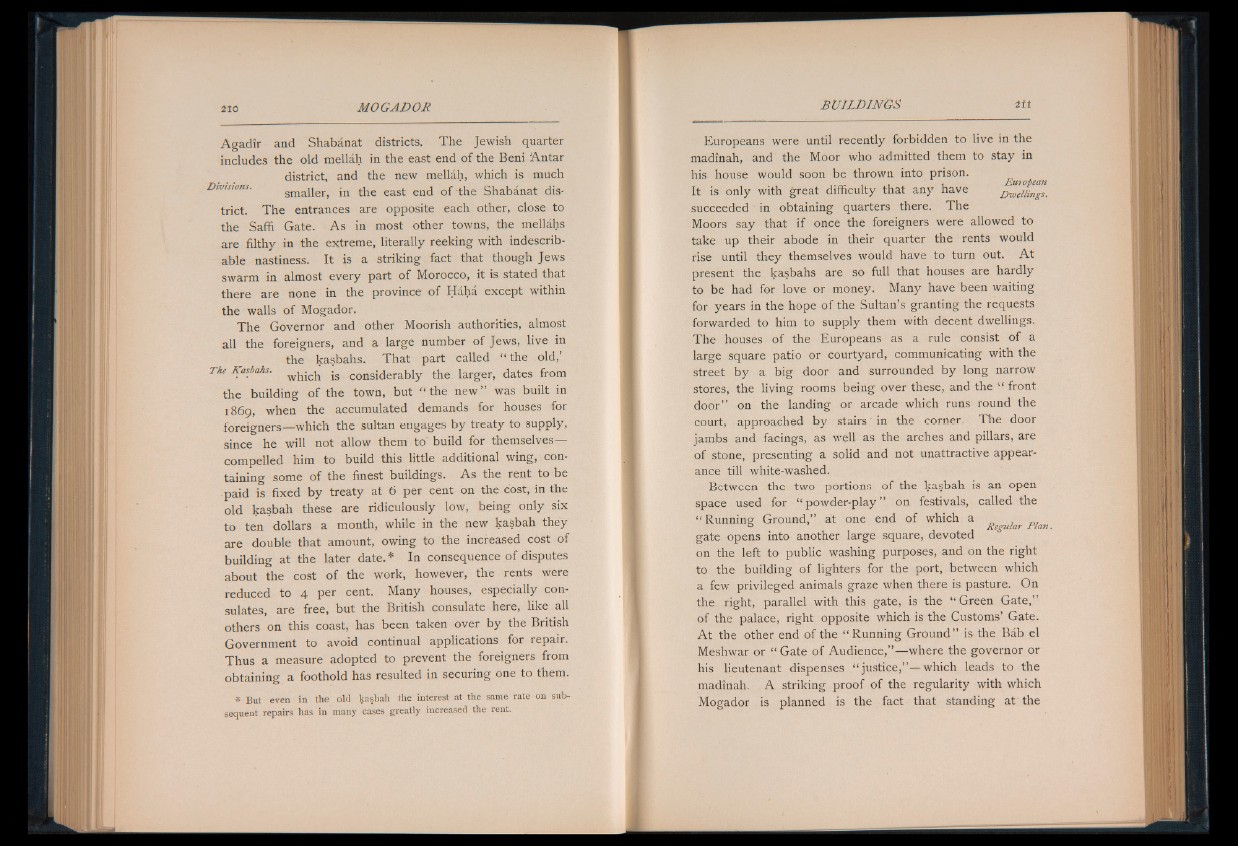
2X0 M0 G AD 0 R
Agadir and Shabanat districts. The Jewish quarter
includes the old mellah in the east end of the Beni Antar
district, and the new mellah, which is much
smaller, in the east end of the Shabanat district.
The entrances are opposite each other, close to
the Saffi Gate. A s in most other towns, the mellahs
are filthy in the extreme, literally reeking with indescribable
nastiness. It is a striking fact that though Jews
swarm in almost every part of Morocco, it is stated that
there are none in the province of Haha except within
the walls of Mogador.
The Governor and other Moorish authorities, almost
all the foreigners, and a large number of Jews, live in
the kasbahs. That part called “ the old,’
The Kasbahs. which is considerably the larger, dates from
the building of the town, but “ the n ew ” was built in
1869, when the accumulated demands for houses for
foreigners— which the sultan engages by treaty to supply,
since he will not allow them to' build for themselves—
compelled him to build this little additional wing, containing
some of the finest buildings. As the rent to be
paid is fixed by treaty at 6 per cent on the cost, in the
old kasbah these are ridiculously low, being only six
to ten dollars a month, while in the new kasbah they
are double that amount, owing to the increased cost of
building at the later date. * In consequence of disputes
about the cost of the work, however, the rents were
reduced to 4 per cent. Many houses, especially consulates,
are free, but the British consulate here, like all
others on this coast, has been taken over by the British
Government to avoid continual applications for repair.
Thus a measure adopted to prevent the foreigners from
obtaining a foothold has resulted in securing one to them.
* But even in the old kasbah the interest at the same rate on subsequent
repairs has in many cases greatly increased the rent.
BUILDINGS i l l
Europeans were until recently forbidden to live in the
madinah, and the Moor who admitted them to stay in
his house would soon be thrown into prison.
1 Emofean
It is only with great difficulty that any have Dwellings.
succeeded in obtaining quarters there. The
Moors say that if once the foreigners were allowed to
take up their abode in their quarter the rents would
rise until they themselves would have to turn out. A t
present the kasbahs are so full that houses are hardly
to be had for love or money. Many have been waiting
for years in the hope of the Sultan’s granting the requests
forwarded to him to supply them with decent dwellings.
The houses of the Europeans as a rule consist of a
large square patio or courtyard, communicating with the
street by a big door and surrounded by long narrow
stores, the living rooms being over these, and the “ front
door” on the landing or arcade which runs round the
court, approached by stairs in the corner. The door
jambs and facings, as well as the arches and pillars, are
of stone, presenting a solid and not unattractive appearance
till white-washed.
Between the two portions of the kasbah is an open
space used for “ powder-play ” on festivals, called the
“ Running Ground,” at one end of which a
gate opens into another large square, devoted
on the left to public washing purposes, and on the right
to the building of lighters for the port, between which
a few privileged animals graze when there is pasture. On
the right, parallel with this gate, is the “ Green Gate,”
of the palace, right opposite which is the Customs’ Gate.
A t the other end of the “ Running Ground” is the Bab el
Meshwar or “ Gate of Audience,”— where the governor or
his lieutenant dispenses “ justice," — which leads to the
madinah. A striking proof of the regularity with which
Mogador is planned is the fact that standing at the